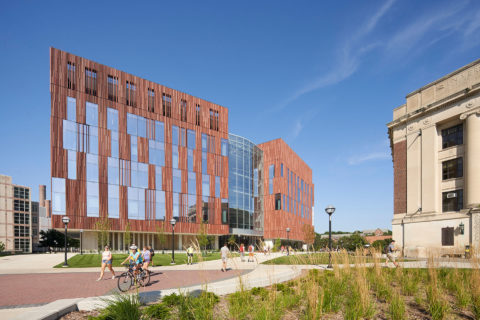
University of Michigan, Biological Sciences Building and Museum of Natural History
Designed specifically for biological science research and sized appropriately for specific research endeavors, lab neighborhoods are small and interconnected, sponsoring intimacy and collaboration. Segmented massing reinforces campus movement: two atriums unify the building’s three volumes. Glazed on both sides, the atriums afford visual connectivity between research and museum spaces.
In an unprecedented coupling of an academic biological science program with a museum of natural history the Michigan Biological Science Building opens up the world of science to the world via the intertwining of the public and the academic sciences. The building was designed to put science on display and encourage collegial interactions between science departments.
The Departments of Molecular, Cellular and Developmental Biology and Ecology and Evolutionary Biology, Natural History, Paleontology and Zoology, and a re-envisioned Museum of Natural History exhibit collections and communicate research conducted at the University.
Merging research, classroom and public exhibition space and adjacent the existing Life Sciences Institute, the building completes a new “Science Neighborhood” for the University and a significant campus crossroads, unifying a residential zone, the life sciences quad and the main axis through campus – the Diag.
Bringing these programs together under one roof will create exciting opportunities for interdisciplinary teaching, research and collaboration. It will also offer a richer experience for museum visitors.
A neighborhood planning approach promotes efficient space use and sharing of equipment, as well as the desired scale for collaboration and community formation: open research laboratories are divided into smaller neighborhoods that co-locate investigators pursuing similar research themes and techniques.
Corridors are minimized, work spaces are separated from the adjacent labs with glass partitions allowing constant visual contact within the research community, and natural light penetrates throughout the spaces.
Large interaction areas enrich the daily working experience, create a shared awareness of activity within the building, and provide places for casual meetings, while formal conference rooms on each floor accommodate faculty presentations, team meetings and research work groups. Shared functional requirements across research groups are served by common customizable laboratory types, organized along a spectrum from wet to dry.
Learning spaces, which are specifically designed to accommodate the display and analysis of research collections, double as University pool classrooms that bring general studies students into the facility.
In addition to state-of-the-art research spaces in biological sciences, the University had the foresight to pair these programs with a replacement of their aging and under-attended Museum of Natural History. Through this unprecedented coupling, the University opens glimpses into hidden scientific processes to the world.
The design celebrates this union by intertwining public exhibit galleries through three research towers and across two shared atrium spaces, giving the public views into the sophisticated research areas.
Details
- Year
- Laboratory: 2018
- Museum: 2019
- Location
- Ann Arbor, MI
- Size
- 295,000 GSF
- Program
- 92 Research Offices, 76 Research Laboratories, Four General Classrooms, Four Large Conference Rooms, Four Small Conference Rooms, Large Interaction Areas, Small Seating Areas, Greenhouse, Growth Rooms and Growth Chambers, Research Support, Natural History Museum, Specimen Artifact Collections, Dining Facilities
- LEED Gold
Team
- Ennead Design Team
- Todd Schliemann, Don Weinreich, Jarrett Pelletier, Charles Griffith, John Majewski, Matthew Dionne, Margaret Tyrpa, Stefan Abel, Michael Caton, Kori Camacho-Onal, Aleks Dawson, Dean Kim, Amy Maresko, Jacob Reidel, Suzanne Troiano, Hsin-Yi Wu
- Architect of Record
- SmithGroup
Awards
- 2021
- 2020
- AIA New York State Design Award, Institutional Category
- Engineering Society of Detroit, Construction & Design Award Winner
- 2019
Press
- 2023
- 2021
- 2020
- 2019
- Briggs, Lisa. "University of Michigan's Biological Sciences Building Brings Life to the "Science on Display" Concept" (CAM Magazine, 10/2019)
- Aghajanian, Liana. "In University of Michigan’s New Sciences Building, Visitors Will Find Labs and Dinosaur Fossils" (Metropolis, 9/10/2019)
- Press Release: University of Michigan’s Biological Sciences Building by Ennead Architects and SmithGroup Celebrates Grand Opening


















